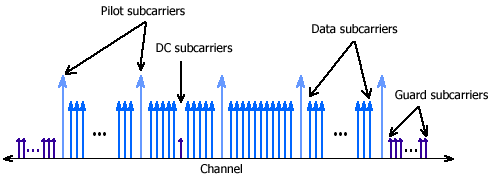Introduction to FDM, OFDM, OFDMA, SOFDMA
Scalable OFDMA (SOFDMA)
SOFDMA (S-OFDMA) adds scalability to OFDMA. It scales the FFT size to the channel
bandwidth while keeping the sub-carrier frequency
spacing constant across different channel bandwidths. Smaller FFT size is
given to lower bandwidth channels,
while larger FFT size to wider channels. By making the sub-carrier frequency
spacing constant, SOFDMA reduces system complexity
of smaller channels and improves performance of wider channels.
As a reminder, IFFT (Inverse Fast Fourier Transform) is used in a WiMAX
transmitter
to create an OFDM waveform from modulated data streams, while FFT (Fast Fourier
Transform) is used in a WiMAX receiver to demodulate the data
streams. The FFT size equals the number of sub-carriers, e.g. in a OFDM/OFDMA system with 256 sub-carriers, the FFT size is 256.

Picture. Transmitter and Receiver RF chains in WiMAX
Basic building blocks of a Tx RF chain and a Rx RF chain.
SOFDMA is the OFDMA mode used in Mobile WiMAX. It supports channel bandwidths
ranging from 1.25 MHz to 20 MHz. With
bandwidth scalability, Mobile WiMAX technology can comply with various
frequency regulations worldwide and flexibly address
diverse operator or ISP requirements, that's whether for providing only basic Internet
service or a broadband service bundle.
OFDM and OFDMA Symbol Structure

Picture. OFDM symbol structure in WiMAX
Both
OFDM and OFDMA symbols are structured in similar way. Each symbol consists of:
- data sub-carriers (OFDM) or sub-channels (OFDMA) that carry data
(information),
- pilot sub-carriers as reference frequencies and for various estimation purposes,
- DC sub-carrier as the center frequency, and
- guard sub-carriers or guard bands for keeping the space between OFDM/OFDMA signals.

Picture. OFDMA symbol structure in WiMAX
sub-carriers of the same color represent a sub-channel.
|